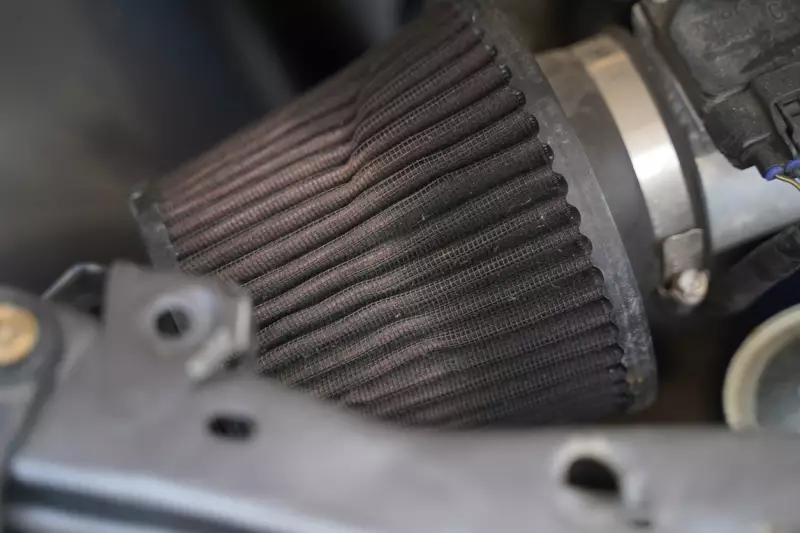The cold air intake represents a cost-effective aftermarket modification that benefits car engines. While power gains provided by cold air intakes may be debatable, there is no gainsaying the significant improvements to engine performance offered. A cold air intake reduces the temperature of the air going into a car to increase the internal combustion engine's power. Consequently, the engine receives a greater volume of oxygen-rich air, leading to improved combustion efficiency and more efficient engine performance.
What Is a Cold Air Intake?
A cold air intake (CAI) is a vehicle performance modification device designed to replace the in-built air intake system included by the vehicle manufacturer. These intake systems are installed outside the engine compartment and have become popular since electronic fuel injection systems were introduced. Although cold air intake designs have evolved since the 1960s, they still comprise an airbox, tube system, and a high-flow filter. Since its introduction, cold air intake systems have become a widely recommended vehicle modification.
What Does a Cold Air Intake Do?
Understanding a car's basic air intake system is required to grasp how a cold air intake system works. A car air intake system is a crucial component of a vehicle's makeup as it operates to bring oxygen, which is a critical component in an internal combustion reaction, into the combustion chamber of the automobile's engine. This process determines how much oxygen combines with burning fuel.
Fuel, spark, and oxygen are required in the automobile's internal combustion engine to provide the energy needed to move a car. Since the atmosphere contains air and fuel only need to mix before exposure to a spark for the required chain reaction to occur. The mixture, when ignited, is sent to the car's engine cylinders, driving the action that is later translated to physical energy, which turns the wheels. At optimum performance, car air intake systems ensure continuous airflow to the engine, offering consistent power and improved mileage for the vehicle.
Cold air intake systems operate in a more advanced manner than the car's basic air intake system. Cold air intake systems bring cooler air into the engine and combustion chamber to boost engine efficiency and power. The combustion reaction generated from cold air intake systems is more powerful because cold air has a higher oxygen density than warm or hot air, and more oxygen can be found in cold air than in hot or warm air.
In a cold air intake system, the car's airbox is replaced with a plastic or metallic tube leading to a conical air filter. The system includes heat shields to protect the cold air filter from engine components in the area, which may get hot after running for a while. The cold air intake ensures the outside air remains cool relative to the air in the engine environment, allowing for more efficient combustion reactions.
How Much Horsepower Does a Cold Air Intake Add?
By providing the engine with cooler air, a cold air intake can add up to 20 horsepower to your vehicle's performance. However, this is only an estimate as the actual horsepower added varies depending on several factors, such as the vehicle make, model, engine size, and intake type.
What Are the Benefits of Cold Air Intake Systems?
Installing a cold air intake in your car offers the following benefits:
- Improved fuel efficiency: Since cold air intake produces better combustion than the factory-installed air intake system, you can experience improvements in fuel economy, especially during heavy load conditions or highway driving. Hence, you can go more miles per gallon, saving money on gas.
- Better engine protection: Most cold air intakes possess high-quality air filters, enabling them to trap contaminants more efficiently, reducing the risk of engine damage that may arise from dirt or debris entering the intake.
- Better throttle response: Cold air is denser than warm. Due to the denser air provided by cold air intake systems, cars can produce more response throttle inputs, resulting in a more engaging driving experience.
- Enhance engine sound: Many drivers have reported experiencing a more satisfying and amplified engine roar or growl, adding special excitement to driving. The aggressive tone is said to provide a thrilling sensation that makes driving more enjoyable.
Overall, cold air intakes can prolong the life cycle of your car's engine by improving air filtration capability and protecting the engine from contaminants. This allows the car to endure more wear and tear, prolonging its life span. Cold air intakes are also easy to install and maintain. With basic tools you can purchase from a local store, you can upgrade your car's intake system with a cold air intake. Furthermore, cold air intake systems only need cleaning or replacement every 30,000-50,000 miles, making them easy to maintain.
Dirty Air Filter Symptoms

Despite its relatively small size, your car's air filter plays a pivotal role in your vehicle's performance. The air filter is your car's first line of defense against contaminants, such as dust, leaves, and dirt. The filter is designed to bring clear air into your vehicle by sifting off all contaminants from entering the engine. However, with time, the filter becomes dirty or clogged, losing its ability to stop contaminants from entering your engine. A clogged air filter can affect your car in the following ways:
- Poor acceleration: Since engines do not work well with contaminated air, your car will respond sluggishly when you try to accelerate if it has a clogged air filter. The vehicle may experience jerking, indicating it is not getting enough oxygen. While the horsepower generated by your engine does not entirely depend on the oxygen amount, a reduced oxygen level translates to lesser horsepower from the engine.
- Reduced engine performance: A clogged air filter can induce idle starts or a misfiring engine. If enough air is not getting inside the engine, the air-to-fuel ratio in the combustion chamber becomes imbalanced, leading to rough idling or hard starts. Consequently, burnt fuel creates a black residue collection around the spark plugs. Once the spark plugs are unable to function appropriately, the sparks needed for combustion may become difficult to generate, leading to poor engine performance.
- Engine noise: If you notice an unfamiliar sound coming from your vehicle's engine, the air filter may be dirty. Clogged air filters produce unusual noises in the engine, unlike your car's typical noises. For instance, if you hear popping or hiccupping noises or feel the car vibrating while driving, one or more spark plugs may have been damaged due to a clogged air filter.
- Reduced gas mileage: If you notice your vehicle using fuel faster than it did in the past, it could indicate a problem with your air filter. If you drive a car using a carburetor, the carburetor mixes fuel and oxygen to ensure a proper ratio between the two. If an improper amount of air is getting to the carburetor, it produces an imbalance, requiring your car to burn more fuel in compensation. However, if your vehicle uses a fuel injection system, a computer controls the amount of gas and air, meaning a clogged filter does not have as much impact on the gas mileage.
- Check engine light: A check engine light may illuminate your dashboard for various reasons. One such reason is when insufficient oxygen gets to your engine. Impurities, such as carbon deposits in your engine, can throw a check engine light.
How to Clean Cold Air Intake Filter
To keep your cold air intake working optimally, you should properly maintain it by cleaning it regularly. Since air regularly passes through the cold air intake filter, it can quickly become covered in grime and dust. You can clean your cold air intake filter using the following step-by-step guide:
- Gather the necessary tools: To ensure a thorough cleaning process for your cold air intake filter, you will need a screwdriver or socket wrench, clean cloth or towel, water source, cleaning solution, and gloves.
- Remove the cold air intake filter: Open the vehicle hood and identify the air intake system. Afterward, remove any clamps or screws using a screwdriver or socket wrench and disconnect any electrical connectors. Carefully remove the cold air intake filter from its enclosure without damaging surrounding components.
- Inspect and assess the filter condition: After removing the filter, visually assess the filter's condition before cleaning. You should check for dirt and debris buildup, discoloration, clogging, and damage or tears. Also, consider the filter age and use by verifying how long it has been used or whether it has reached its recommended lifespan.
- Clean the cold air intake filter: If your cold air system uses an oiled filter, submerge the filter in a mixture of warm water and a suitable oiled filter cleaning solution. Agitate the filter in the mix to ensure all surfaces are thoroughly cleaned. Afterward, rinse the filter with clean water to remove all residue and then allow the filter to air dry.
If your cold air intake uses a dry fabric filter, use a soft-bristle brush or compressed air to remove loose dirt from the filter. Then, a dry fabric filter cleaner should be applied to the surface of the filter. Leave the filter for 15 to 30 minutes for the cleaner to penetrate, then rinse the filter with water until all residue is gone. Air dry the filter.
- Dry and reinstall the filter: Once you have confirmed no moisture is left, reinstall the filter carefully by placing it gently into its housing, ensuring a secure fit without misalignment or gaps. Tighten the screws or clamps removed earlier to secure the air intake system.
How Often to Change Cold Air Intake Filter

The frequency of how often you should change your cold air intake filter depends on factors such as the environment in which you drive, manufacturer recommendations, and your driving type. However, as a rule of thumb, you should consider changing your cold air intake filter every 12,000 - 15,000 miles to maintain the system's optimal performance. If you drive on dirt roads or dusty conditions, consider changing the filter more frequently as the amount of debris entering the engine increases in dustier conditions. Check the maintenance schedule provided by your car manufacturer for a more appropriate schedule.
How Much Does a Cold Air Intake Cost?
The cost of a cold air intake varies depending on factors such as the vehicle's make and model, the intake system's components, and whether the system is a universal or brand-specific fit. Generally, basic universal kits cost between $50 and $150, while vehicle-specific fits cost between $200 and $500. High-performance cold air intake systems used for specific purposes, such as racing, may cost up to $1,000 or more.
Conclusion
Investing in a cold air intake system can significantly benefit car enthusiasts looking to improve their vehicle’s performance. A cold air intake increases airflow into the engine, resulting in more horsepower and torque, enhancing the power and performance of your car. Cold air intakes maximize combustion efficiency and reduce the strain on other engine components by allowing cooler, denser air inside the engine. Hence, you can improve fuel efficiency and prolong the life of your automobile engine.
When selecting a cold air intake system for your vehicle, it is important to consider certain vital factors to ensure optimal compatibility and performance. Important considerations include assessing compatibility with your vehicle's make and model, checking the brand's reputation, and assessing design features such as the filtration system and heat shield. Additionally, read customer reviews for insights into the real-world performance and reliability of the intake system.
Note that installing a cold air intake may require an engine tune-up. The modifications required to your car's airflow can impact the internal workings of the vehicle and cause problems. Therefore, it is recommended that you consult with a professional mechanic before making modifications to your car's air intake system.








![Best Sites to Check a Car’s History [2025 Review]](https://media.infopay.net/thumbnails/K8lMeG2QLjE46LPqZlmoi6SunKKdT5qvlaRZk6e1.webp)










![Best Sites to Check a Car’s History [2025 Review]](https://media.infopay.net/thumbnails/K8lMeG2QLjE46LPqZlmoi6SunKKdT5qvlaRZk6e1-w356.webp)
